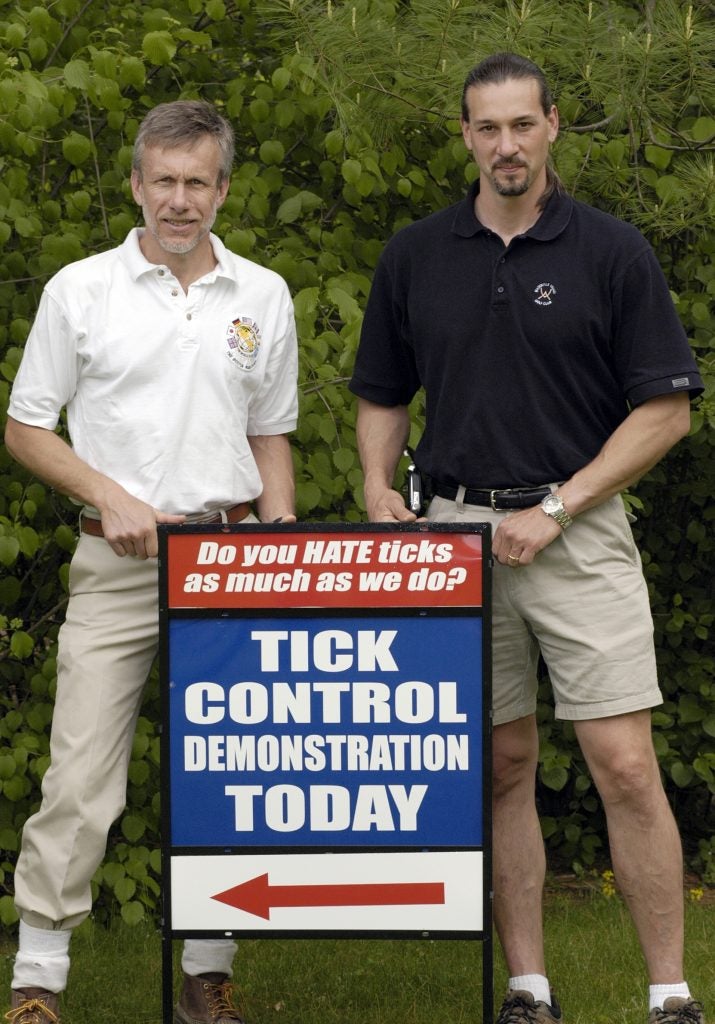There are a lot of fairly simple things that people can do to help protect against ticks but most people also could use a “just-in-time” nudge to help remember to do them.
Back in 2004, before we had TickEncounter, our main outreach and tick education platform was our TickSmart backyard program. We also had a statewide blacklegged tick survey, actually started in 1993, and had pin-pointed high tick-risk areas around Rhode Island. And so, we began an aggressive community organizing campaign to help residents living in the highest tick-risk neighborhoods develop tick protection plans. We would recruit one willing neighbor to host a group of neighbors for an evening backyard tick education program. We’d invite a local pest control company and representatives of veterinary products to attend, and the event became a bit like matchmaking—tick experts introducing people with tick prevention products and services to people who desperately needed those services.

Those were great listening sessions for our team. We heard neighbors saying to neighbors—“Did you know…because I didn’t?” and “…this is news to me.” We were encouraged when whole neighborhoods signed up for tick spray protection. When we would drag our tick flag around the perimeter of the host yard, people practically knocked each other over as they rushed to see the tiny ticks we had just collected. It was clear that people responded positively to the message and they took actions—buying products for their pets, permethrin for their clothes, spray treatments for their yards. With just our presence in their space, it seemed we had broken some kind of barrier holding them back from taking appropriate actions to protect themselves and their families from ticks. I called it the power of the reveal. Later, we would hold focus group sessions in other communities which confirmed people either were unaware or uncertain about effective tick protection so, basically they DID NOTHING! Psychologists call it “decision anxiety.”
A common comment I heard–then, and still hear now–went something like this…“hey Doc, just tell me what I need to know when I need to know it!” While we were always thinking about ticks, it was clear that the general public wasn’t and didn’t want to either. Of course, they wanted to be safe but with different ticks transmitting different germs, and different types and stages of ticks being active at different times of the year and in different habitats, tick protection seemed, well…complicated. There are also two other important but “out-of-sight-out-of-mind” factors associated with ticks that come in to play; ticks are stealthy and don’t announce their presence like whiney-winged mosquitoes do. You rarely know you’re being bitten, at least not right away. Additionally, summer-time risk for Lyme disease is magnified mostly because it is carried by poppy-seed sized nymph-stage ticks that pretty much require a magnifying glass for most people to even see them.

Protecting against ticks is just not as straight-forward as clicking a seatbelt or slathering on sunscreen. Strategies for personal protection against nymphs is different from adult stage ticks, as the nymphs active in May through July first latch on at shoe level but adult stage ticks, which become active in October, first latch on higher up, about knee high. There’s no vaccine, no easy no-brainer action to take that doesn’t require vigilance. There are a lot of fairly simple things people can do to help protect themselves–like wearing tick repellent clothing treated with permethrin, tucking in shirt-tails especially when adult ticks are active, spraying shoes with permethrin when nymphs and larvae are active, daily tick checks, spraying yards with effective products, keeping protection on pets all through the year, not letting “out then in” pets sleep with you—these are some of our favorite and most effective TickSmart actions and tips. But they either cost money or time and, it turns out, require a pretty significant behavior change for the vigilance required, and without any immediate gratification as a reinforcing reward. People aren’t good at taking actions “just in case” they might encounter a tick. And they are largely left uncertain of how effective their efforts are going to be.

Since those early days, we’ve continued to search for solutions to the tick problem. We’ve tried to lobby health insurance companies to help incentivize adoption of tick prevention behaviors. We created a national on-line presence providing tick victims with access to a TickExpert, and other guides for choosing scientifically-proven effective tick protection. We’ve tested repellent and tick-killing products, and even have on-going research to find an effective anti-tick vaccine. We are committed to finding even more effective ways for “nudging” people to prevent tick bites and disease. So, that brings us back to “tell me what I need to know when I need to know it!” Sounds like what’s needed is a calendar of TickSmart tips and actions–spelling out things to do and when to do them–it might be helpful! We’ve just created a simple guide that you can add to your Google calendar. It gives you seasonally-appropriate month-by-month TickSmart actions just when you should be doing them. We promise it won’t crowd your existing calendar as it’s usually no more than 4-5 entries per month. But we’ve also included a few time-relevant TickSmart tips, too, helping you be ready for ticks. Click the button below to add this unique TickSmart Tips calendar to your Google calendar today. And stay tuned as we role out other “just in time” learning tools to help you prevent tickborne disease.
